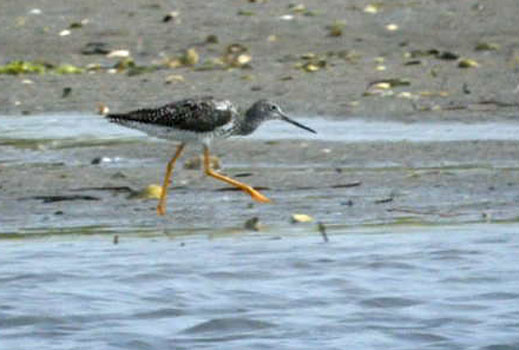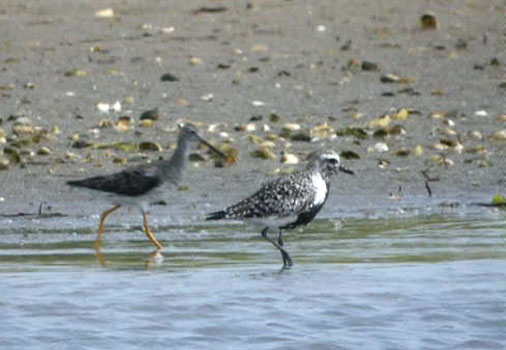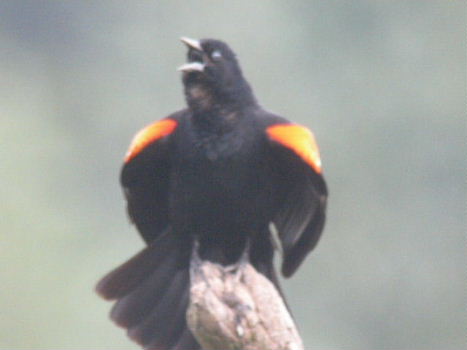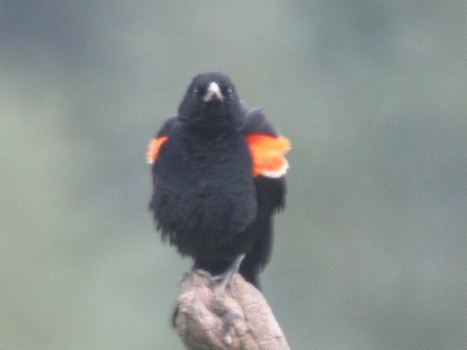Breakfast at The Bathtub
For good eating and great scenery the best place on Nantucket Island is The Bathtub on Eel Point; that is, if you’re a Black-bellied Plover or a Short-billed Dowitcher or some other kind of shorebird. The Bathtub is a tidal cove separated from the open Atlantic by an arc of sandbars. Protected from the wind and with warm shallow water The Tub offers a nice bit of wet sand at low tide where shorebirds can enjoy some fine dining.
I can remember how alive and noisy it was with birds the last time I was there, looking through my stepdad’s spotting scope. So I was eager to head out there with my own digiscoping set up, and was pleased to find that the Nantucket Maria Mitchell Association had a bird walk planned at The Bathtub.
A large freshwater saltmarsh run parallel to The Tub and attracts birds that might not be seen in other habitats, such as the Saltmarsh Sharp-tailed Sparrow. We did not spot one that morning but now it’s another reason to come back again next year. The open grassy dunes are also home to Northern Harriers (Marsh Hawks) and that morning we were treated to a brief visit from a Merlin. I believe I saw fox tracks in the sand as well.
Below a Black-bellied Plover scouts the shore for food. These birds will see something, hold a poise then scurry forward to grab it, like a cat frozen before the pounce. I have recently learned that it is believed the plovers detect the presence of worms by the outwardly gushing water from wormholes in the sand.
The wet sand menu consists of bivalves, beetles, an extensive variety of fly larvae, and the all-time favorite Polychaetes (Bristle worms), including those fabu-liscious ziti-thin worms (Notomastus, Scoloplos, etc.) that can be easily yanked from the substrate and gulped down in less than a second.
Below are a couple of stills from a video I took of a Lesser Yellowlegs cruising on a serious foraging mission along the opposite shore.
These birds love just about anything; beetles, fly larvae, small fish, worms, and even fish scales. Yes, according to one 1927 article the stomach contents of 9 Lesser Yellowlegs studied in Puerto Rico consisted of .33% fish scales. (Another interesting fact from Birds of NA Online - worth subscribing to if you’re into birds).
Despite the pleasant offerings and morning atmosphere of The Bathtub, nature is nature and some patrons will eat others. This Peregrine Falcon had killed a gull or tern, and was busy munching it down.
Other birds seen that morning were Snowy egrets, Cormorants, Herring gulls, a Great Black-backed Gull, American Oystercatchers, and Semipalmated Plovers.
However, I could have spent all day photographing one particular modest flock of Semipalmated Plovers who took time out from foraging to have a bath.


A vigorous shaking and fluffing completes a refreshing bath.
The ambience of The Bathtub made the experience all the better. There was the eerie howling of Gray Seals coming across from outer sandbars beyond The Tub like wind hooing through the eaves of an old house. There was a gentle breeze rustling dune and saltmarsh grasses. There were birds having a good time, and fun bird folk to enjoy with whom to enjoy it all. The Eel Point Bathtub is a 5-star place to visit for birds and bird people alike.























